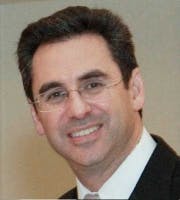By Martin Jablow DMD, FAGD© Dreamstime.com
Lasers have been used in dentistry for more than 20 years. We have gone from treating only soft tissue to treating hard tissues such as teeth and bone. The cost of soft-tissue lasers has decreased along with their size. General dentists can now easily integrate lasers into their practices. Laser is an acronym that stands for Light Amplification by Stimulated Emission of Radiation. Light is measured in wavelengths. Dental laser wavelengths are Diodes 830-1,064nm, Nd:YAG 1,064nm, Erbium 2,790-2,940nm, and CO2 9.3-10.6nm. Every wavelength has a specific thermal output and specific tissue interaction that is always predictable. The different wavelengths for dental lasers perform different procedures. The most common dental lasers go by acronyms that are associated with how the laser light is produced. They include Diode, Nd:YAG, Er:YAG, or CO2. The dental laser manufacturers give the lasers names, but in many cases the wavelength of the laser is identical to another. It then becomes about the customization of the hardware and the number of parameters a dentist wants to control.There are a few basics for using lasers safely. Laser eye safety is extremely important and should never be compromised. A laser can easily damage the human eye. The patient, dentist, and assistant should always wear protective eyewear. There are inserts available for dentists who wear surgical telescopes. It is recommended that the use of oxygen and nitrous oxide/oxygen should be turned off when using a laser.Nd:YAG, Diode lasers, and CO2 are primarily used on soft tissue. These lasers provide good coagulation. The laser energy of the Diode and Nd:YAG can penetrate a few millimeters into the tissue. A CO2 laser penetrates less than a millimeter and can produce excellent coagulation along with a very precise cut. Erbium wavelength lasers can cut tooth, bone, and soft tissue. Erbium lasers have an affinity for water. Erbium lasers are not good at providing hemostasis but are kind to tissue, as they only penetrate microns into tissue. The first question that a dentist needs to ask before buying a laser is: What do I want the laser for? Then ask: Will I use it exclusively for soft-tissue work? Do I have the room for a large erbium laser box in my operatory? Do I want to prep teeth and bone? Your choice of a laser will be dictated by the answers to these questions. The goal is to choose the correct laser and wavelength for the procedure you want to accomplish.Laser procedures are usually divided into hard and soft tissue. Soft-tissue laser procedures are for periodontal treatment. Oral surgery, such as biopsies and frenectomies, can be accomplished with all soft-tissue lasers.Now you need to choose the soft-tissue laser with the proper wavelength. If you want a laser for soft-tissue periodontal procedures, I would recommend an Nd:YAG as there is lots of supportive literature. Other procedures can be accomplished with either Nd:YAG, CO2, or Diode lasers. Soft-tissue lasers offer better visualization of the surgical field, because they cut and seal at the same time.Periodontal procedures such as the laser-assisted new attachment procedure (LANAP) allow for minimally invasive surgery as an alternative to conventional flap surgery. The laser is placed into the periodontal sulcus and removes the diseased epithelium. Scaling is performed to remove calcified plaque and calculus from the root surfaces. The Nd:YAG produces a bactericidal effect in the pocket. Some individuals have had regeneration of cementum, bone, and periodontal ligament while reducing pocket depth.Nd:YAG, Diode, CO2, or Er:YAG lasers can also be used for the destruction of aphthous ulcers. A laser can transform a sore that hurts into a sore that does not hurt, with more rapid healing. Advantages of soft-tissue lasers may include minimal postoperative pain, minimally invasive surgeries, and in many cases, the elimination of sutures. Second-stage implant surgery can be safely accomplished with Diode, Erbium, and CO2 lasers.The KaVo DIAGNOdent uses a laser to help identify caries. Diagnostic lasers can be used to detect smooth surface, interproximal, and pit and fissure caries. These lasers operate at a wavelength of 655nm and are red in color. At this wavelength healthy enamel and dentin have little or no fluorescence. The laser light causes the carious areas of the tooth to fluoresce. The fluorescence is then measured, and the determination of caries can be made. Laser caries detection offers greater sensitivity than conventional visual and tactile methods. Early diagnosis of carious lesions makes minimally invasive dentistry possible.Erbium-based lasers (Er:YAG and Er,Cr:YSGG) can do both hard- and soft-tissue procedures. Many general dentists are looking to lasers to prepare teeth for restorations. Erbium lasers are effective for caries removal and cavity preparation. Many procedures can be done with an Erbium laser without anesthesia, and these lasers make treating pediatric patients easier. Erbium lasers do not cut teeth as fast as a high-speed handpiece, but they are much more conservative when preparing teeth. Erbium lasers can be used to remove composites but not amalgam restorations. Soft-tissue procedures with an Erbium laser can produce more bleeding compared to soft-tissue-only lasers. The major objections most dentists have to lasers are cost and limited procedures. Lasers are perfect for minimally invasive dentistry. The more healthy tooth structure conserved during a procedure, the better the long-term health of the tooth. A laser may never replace a high-speed handpiece, but it is another tool to better assist the dentist.Dentists need to become knowledgeable in the use of lasers so they can maximize the number of procedures that a laser can accomplish. As for cost issues, some soft-tissue lasers are available for less than $3,000, so a laser can be within reach of every dental office. It is just a matter of dentists deciding to educate themselves on the benefits of lasers.
Martin Jablow, DMD, FAGD, received his dental degree from New Jersey Dental School in 1986 and practices in Woodbridge, N.J. He received his fellowship in the Academy of General Dentistry and is certified in various laser wavelengths. He is a member of the American Dental Association and the New Jersey Dental Association. He is an attending dentist at John F. Kennedy Medical Center in Edison, N.J., as well as a long-time member of his county’s Peer Review Committee. Dr. Jablow is president of Dental Technology Solutions, a lecture and consulting company. Dr. Jablow is the writer of the Dr. Bicuspid.com Question and Answer column called “Ask Marty.” He also writes a monthly column for Dental Learning Hub’s Apex magazine. Dr. Jablow has spoken at many major dental meetings including the ADA Annual Session, the Yankee Dental Congress, and the California Dental Association. Consulting with various high-technology companies, Dr. Jablow is involved in the process of improving established products and testing new products and techniques. He consults with dental offices on implementing computers and technology into their practices. Dr. Jablow enjoys promoting the use of technology in the dental office through lecturing and writing articles for various national dental publications, with an emphasis on improving patient care.








